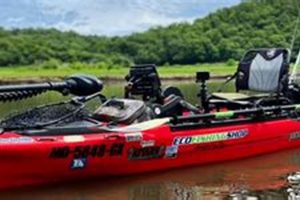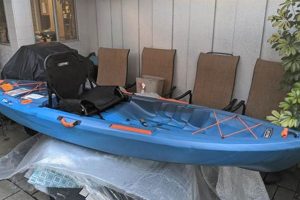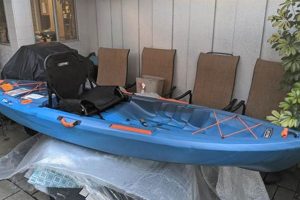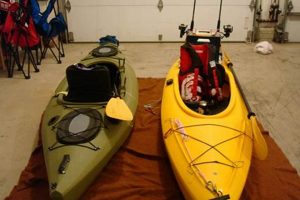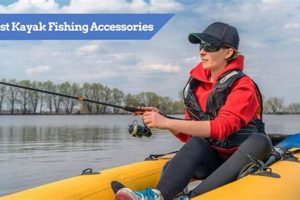Specialized equipment designed to enhance the experience and effectiveness of angling from a kayak falls under this category. Examples include rod holders, anchor systems, and specialized storage solutions for flies and tackle. These items are often designed for compact portability and ease of use in the confined space of a kayak.
Effective angling from a kayak requires adapting traditional fly fishing practices to a watercraft environment. Gear tailored to this specialized pursuit offers significant advantages, including improved line management, increased casting efficiency, and secure equipment storage. This contributes to a more streamlined and enjoyable fishing experience, allowing anglers to focus on the sport rather than managing gear in a challenging environment. Historically, anglers adapted existing equipment; however, the growing popularity of kayak fishing has spurred innovation and the development of purpose-built accessories.
The following sections will delve into specific categories of these essential items, exploring their functionalities, benefits, and selection criteria. Topics covered will include rod and paddle management, anchoring and positioning systems, storage solutions, safety equipment, and electronics integration.
Tips for Optimizing Kayak Fly Fishing Accessories
Strategic selection and utilization of specialized equipment significantly enhance angling success and overall enjoyment. Consider these key recommendations to maximize the benefits of a kayak fishing setup.
Tip 1: Prioritize Stability. A stable kayak platform is paramount for effective casting and line management. Consider wider, flatter-bottomed kayaks for increased stability, especially in moving water. Anchor systems, including stake-out poles and drift socks, further enhance stability in varying conditions.
Tip 2: Streamline Gear Storage. Efficient organization is crucial in a limited space. Utilize specialized tackle boxes, fly patches, and storage bags designed for kayak use. Prioritize readily accessible storage for frequently used items like flies, leaders, and tippet material.
Tip 3: Optimize Rod and Paddle Placement. Securely mounted rod holders allow for hands-free lure changes and fish handling. Choose adjustable rod holders to accommodate varying rod lengths and casting angles. Ensure paddle storage is readily accessible yet secure to prevent interference during casting.
Tip 4: Select Appropriate PFDs. Personal flotation devices (PFDs) designed for fishing offer integrated pockets and attachment points for tools and accessories. Ensure the PFD fits comfortably and allows for unrestricted casting motion.
Tip 5: Integrate Electronics Strategically. Fish finders and GPS units enhance angling effectiveness. Mount these devices within easy view and reach, utilizing RAM mounts or similar systems. Consider waterproof cases for added protection.
Tip 6: Choose Specialized Tools. Opt for compact and corrosion-resistant tools designed for saltwater or freshwater environments, as appropriate. Line cutters, pliers, and hemostats are essential components of any kayak fishing kit.
Tip 7: Consider Anchor Deployment Strategies. Different anchoring systems suit specific water conditions. Stake-out poles provide stability in shallow water, while drift socks control drift speed in rivers. Practice deploying and retrieving these systems efficiently.
By adhering to these recommendations, anglers can create a customized and highly functional kayak setup that enhances both efficiency and enjoyment on the water.
The concluding section offers a brief recap of key considerations for optimizing kayak fly fishing accessories and emphasizes the importance of individualized setup based on personal preferences and fishing style.
1. Rod Holders
Rod holders constitute a critical component within the broader category of kayak fly fishing accessories. Their primary function is to secure fishing rods, freeing an angler’s hands for other essential tasks, such as paddling, adjusting tackle, or landing fish. This functionality significantly enhances safety and efficiency while on the water. Without secure rod storage, rods are susceptible to damage or loss, especially during navigation through challenging waters or when encountering unexpected obstacles. Furthermore, attempting to manage a rod while simultaneously performing other tasks increases the risk of capsizing or losing balance. For example, navigating through narrow, debris-filled waterways necessitates two free hands for paddling. A rod holder safeguards the rod during such maneuvers.
Several types of rod holders exist, each tailored to specific needs and kayak configurations. Flush-mount rod holders offer a low-profile option, minimizing interference with casting. Adjustable rod holders provide flexibility in positioning the rod at various angles, optimizing presentation based on fishing conditions. Rotating rod holders allow for quick adjustments in rod orientation, facilitating various fishing techniques. Selecting the appropriate rod holder depends on individual fishing style, target species, and kayak layout. An angler targeting larger, more powerful fish might prioritize a heavy-duty rod holder with enhanced locking mechanisms, while someone focused on finesse presentations might opt for a more adjustable model that prioritizes precise rod positioning.
Proper rod holder placement and installation are essential for maximizing their effectiveness. Positioning rod holders within easy reach but outside the primary paddling arc prevents interference and maximizes accessibility. Secure mounting ensures rods remain stable even during aggressive maneuvers or when battling strong fish. Neglecting these considerations can lead to frustration, reduced efficiency, and potential equipment damage. Ultimately, strategically selecting and positioning rod holders contribute significantly to a safer, more organized, and ultimately more productive kayak fly fishing experience.
2. Anchoring Systems
Anchoring systems represent a crucial subset of kayak fly fishing accessories, enabling anglers to maintain position and control drift in diverse water conditions. Effective anchoring enhances presentation accuracy, reduces fatigue from constant repositioning, and optimizes fishing within specific target zones. Selecting an appropriate anchoring system depends on factors such as water depth, current strength, bottom composition, and fishing style.
- Stake-Out Poles:
Stake-out poles provide a simple and effective anchoring solution in shallow water environments. These poles, typically constructed from lightweight, durable materials like aluminum or fiberglass, are manually deployed by inserting the pointed end into the bottom substrate. A length of rope or cord secures the kayak to the pole, allowing for adjustable positioning. This system excels in calm waters with firm bottoms, such as shallow flats or river margins, and offers quiet deployment, minimizing disturbance to fish.
- Anchor Trolleys:
Anchor trolleys offer enhanced control and maneuverability when utilizing traditional anchors. These systems, typically consisting of a series of pulleys and ropes, allow anglers to adjust anchor position from the seated position, enabling precise adjustments to drift and positioning within a target zone. This system is particularly advantageous in deeper water or when facing changing wind or current conditions. Anchor trolleys facilitate quick adjustments to maintain optimal presentation without requiring constant repositioning of the kayak.
- Drift Socks/Anchors:
Drift socks or drift anchors offer an alternative approach to controlling drift, particularly in rivers or moving water scenarios. These cone-shaped devices create drag in the water, slowing the kayak’s drift and allowing for more controlled presentations. They are particularly useful when fishing downstream or maintaining position in a current. Selecting an appropriately sized drift sock or anchor depends on factors such as kayak size, current speed, and desired drift rate.
- Folding Grapnel Anchors:
Folding grapnel anchors offer a compact and versatile anchoring solution for various bottom types. Their collapsible design facilitates easy storage and deployment. The multiple flukes enhance holding power in diverse substrates, from sand and mud to rocky bottoms. Selecting an appropriately weighted anchor depends on kayak size, water depth, and anticipated current strength. Oversized anchors can be cumbersome and difficult to retrieve, while undersized anchors may fail to hold effectively.
Effective anchoring contributes significantly to an optimized kayak fly fishing experience. Choosing the appropriate system, considering factors like water conditions and fishing style, allows anglers to focus on presentation and technique, ultimately enhancing efficiency and enjoyment on the water.
3. Specialized Storage
Within the context of kayak fly fishing accessories, specialized storage solutions play a critical role in maintaining organization and accessibility of essential gear. Limited space within a kayak necessitates efficient storage systems designed to protect equipment from the elements while ensuring quick retrieval during critical moments. Effective storage contributes directly to an angler’s efficiency and overall fishing success by minimizing time spent searching for gear and maximizing time spent fishing.
- Tackle Boxes and Fly Patches:
Specialized tackle boxes and fly patches designed for kayak fishing prioritize compact design and waterproof construction. These systems often feature compartments tailored to hold various fly sizes and patterns, leaders, tippet material, and other small accessories. For example, waterproof fly boxes with silicone inserts maintain fly organization and dryness, even in challenging conditions. Secure closures and latching mechanisms prevent accidental spills, preserving valuable equipment and maintaining organization.
- Dry Bags and Waterproof Cases:
Dry bags and waterproof cases offer essential protection for sensitive electronic devices, cameras, and personal items like phones and wallets. These storage solutions provide a barrier against water intrusion, safeguarding valuable equipment from damage. Submersible dry bags are particularly valuable in the event of a capsize, ensuring critical items remain dry. Clear waterproof cases allow for visibility and operation of touchscreens without removing devices from their protective enclosures.
- Kayak-Specific Storage Solutions:
Kayak manufacturers often integrate specialized storage compartments within the kayak’s design, including hatches, tank wells, and under-seat storage areas. These purpose-built compartments offer convenient storage for larger items like extra clothing, food and water, and safety equipment. Aftermarket accessories, such as deck bags and crate systems, further expand storage capacity and allow for customized organization based on individual needs and preferences.
- Gear Tethers and Lanyards:
Gear tethers and lanyards provide an added layer of security, preventing accidental loss of essential tools and accessories. Attaching frequently used items like pliers, nippers, and line cutters to tethers ensures they remain readily accessible while mitigating the risk of dropping them overboard. This simple yet effective measure can save valuable time and prevent the loss of essential equipment.
Strategic implementation of specialized storage solutions contributes significantly to a streamlined and productive kayak fly fishing experience. By maximizing organization and accessibility, anglers can focus on the task at hand, optimizing efficiency and overall enjoyment on the water. Choosing the right combination of storage solutions depends on individual needs, fishing style, and kayak configuration.
4. Safety Equipment
Safety equipment constitutes a critical component of kayak fly fishing accessories, prioritizing angler well-being and preparedness for unforeseen circumstances. While specialized fishing gear enhances angling performance, safety equipment safeguards against inherent risks associated with on-water activities. Understanding and utilizing appropriate safety measures contribute significantly to a responsible and enjoyable fishing experience.
- Personal Flotation Devices (PFDs):
PFDs are paramount for kayak anglers, providing buoyancy and increasing survivability in the event of capsizing or accidental immersion. Selecting a comfortable, well-fitting PFD designed for fishing allows for unrestricted casting motion while providing essential flotation. Inflatable PFDs offer a less bulky alternative to traditional life vests, but require regular maintenance and inspection to ensure proper functionality. Wearing a PFD is non-negotiable for safe kayak fishing practices.
- Signaling Devices:
Signaling devices, including whistles, air horns, and visual distress signals, are essential for attracting attention in emergency situations. A whistle attached to the PFD provides a readily accessible means of signaling for help. Air horns offer greater audibility, particularly in foggy conditions or open water. Visual distress signals, such as flares or signal mirrors, can attract attention from greater distances. Carrying a combination of signaling devices increases the likelihood of successful communication in an emergency.
- First-Aid Kit:
A comprehensive first-aid kit tailored to on-water emergencies is crucial for addressing minor injuries and providing initial care for more serious incidents. Essential items include waterproof bandages, antiseptic wipes, pain relievers, sunscreen, insect repellent, and any personal medications. A compact, waterproof first-aid kit stored in a readily accessible location ensures preparedness for common fishing-related injuries, such as hook punctures or minor cuts.
- Communication Devices:
Maintaining communication capabilities is vital for safety, particularly when fishing in remote locations or challenging conditions. A waterproof cell phone or VHF radio allows for communication with emergency services or shore contacts in case of unforeseen circumstances. Informing someone of fishing plans, including intended location and return time, adds another layer of safety. Regularly checking weather forecasts before and during outings allows anglers to anticipate and respond to changing conditions.
Prioritizing safety equipment alongside specialized fishing accessories contributes significantly to a responsible and enjoyable kayak fly fishing experience. While maximizing fishing performance is a desirable outcome, ensuring angler safety remains paramount. Integrating these safety measures enhances preparedness for unforeseen events, fostering a secure and ultimately more rewarding time on the water.
5. Electronics Integration
Electronics integration significantly enhances the kayak fly fishing experience, transforming the way anglers navigate, locate fish, and understand underwater environments. Integrating electronic devices into kayak fishing setups expands angling capabilities and contributes to more informed decision-making on the water. This integration, however, requires careful consideration of mounting solutions, power management, and device compatibility with the kayak fishing environment.
Fish finders represent a key electronic tool for kayak anglers. These devices utilize sonar technology to generate real-time images of the underwater terrain, revealing bottom structure, depth contours, and fish locations. This information informs strategic decisions regarding lure selection, presentation techniques, and fishing location. GPS units, often integrated with fish finders, provide precise location data, enabling navigation to productive fishing spots, marking waypoints, and tracking drift patterns. Integrating these devices onto a kayak requires specialized mounts, such as RAM mounts or track systems, ensuring secure placement within easy view and reach of the angler. Furthermore, powering these electronics requires portable battery packs or dedicated kayak wiring systems to provide a reliable power source. For example, a kayak angler might use a fish finder to locate submerged structures holding fish, then utilize GPS waypoints to return to these productive locations on subsequent trips. Integrating these electronics streamlines the fishing process and increases the likelihood of success.
Effective electronics integration requires balancing functionality with practicality. Choosing waterproof and shock-resistant devices ensures durability in challenging on-water conditions. Compact designs minimize space requirements within the limited confines of a kayak. Furthermore, understanding device operation and interpreting data displayed contributes directly to angling effectiveness. While these electronic tools enhance fishing capabilities, they do not replace fundamental angling skills and knowledge. Successfully integrating electronics into a kayak fly fishing setup requires strategic planning, careful selection of appropriate devices and mounting systems, and an understanding of how these tools can enhance on-water decision-making.
6. Fishing Tools/Accessories
Fishing tools and accessories represent an integral component of the broader category of kayak fly fishing accessories. While the kayak itself provides the platform and specialized kayak accessories like rod holders and anchors enhance on-water functionality, fishing tools directly impact an angler’s ability to effectively manage lines, handle fish, and address common angling challenges. These tools bridge the gap between angler and quarry, facilitating successful hooksets, efficient releases, and responsible fish handling. The selection and utilization of appropriate fishing tools directly influence angling success and contribute to a more streamlined and enjoyable experience on the water. For example, specialized pliers designed for cutting braided fishing line are essential for rigging and addressing line tangles, while a knot-tying tool assists in creating strong, reliable connections between leader and tippet material. These tools, while seemingly small, play a crucial role in the overall success of a kayak fly fishing outing.
Several key fishing tools and accessories prove particularly valuable in the context of kayak fly fishing. Compact, corrosion-resistant pliers with integrated cutters and crimpers facilitate line management, hook removal, and rigging adjustments. Specialized forceps or hemostats aid in removing deeply embedded hooks, minimizing stress on the fish during release. A sharp knife or line cutter facilitates quick line adjustments and releases tangled lines. Nippers designed specifically for trimming fly-tying materials ensure precise and efficient trimming of threads and other delicate components. Furthermore, a waterproof fly box with compartments tailored to hold various fly sizes and patterns keeps flies organized and readily accessible, maximizing fishing efficiency. These tools, when organized within easy reach, contribute significantly to a streamlined and productive fishing experience.
The thoughtful selection and organization of fishing tools and accessories within a kayak fishing setup directly impact an angler’s effectiveness and overall enjoyment. Prioritizing essential tools, considering factors like target species, fishing techniques, and personal preferences, optimizes on-water performance. Efficient organization within limited kayak space further enhances accessibility, allowing anglers to focus on fishing rather than searching for misplaced tools. Understanding the function and application of various fishing tools enhances an angler’s ability to adapt to changing conditions and effectively address common challenges encountered during kayak fly fishing excursions.
Frequently Asked Questions
This section addresses common inquiries regarding specialized equipment for kayak fly fishing, aiming to provide clear and concise information for anglers seeking to optimize their on-water experience.
Question 1: What are the most essential accessories for kayak fly fishing?
Essential accessories include a comfortable and appropriately sized personal flotation device (PFD), a stable and maneuverable kayak, a well-balanced fly rod and reel, a selection of appropriate flies, and a secure method for storing and accessing tackle. Additional accessories, such as rod holders, anchors, and specialized storage solutions, further enhance efficiency and enjoyment.
Question 2: How does one choose the right kayak for fly fishing?
Kayak selection depends on individual needs and fishing environment. Factors to consider include stability, maneuverability, storage capacity, and seating comfort. Wider, flatter-bottomed kayaks offer increased stability, while shorter kayaks provide enhanced maneuverability in tight spaces. Sit-on-top kayaks are generally preferred for their ease of entry and exit, as well as self-bailing capabilities.
Question 3: What are the benefits of using a specialized fly rod for kayak fishing?
Shorter fly rods, typically between 7 and 9 feet in length, are often preferred for kayak fishing due to their enhanced maneuverability in confined spaces. These shorter rods facilitate casting in close proximity to the water’s surface, optimizing presentation accuracy and minimizing interference with surrounding obstacles.
Question 4: How can one prevent gear from getting wet while kayak fishing?
Utilizing waterproof storage solutions, such as dry bags, waterproof tackle boxes, and sealed containers, protects sensitive gear from water damage. Securing gear within the kayak’s storage compartments or utilizing deck bags with waterproof liners provides additional protection against splashes and unexpected immersion.
Question 5: What safety precautions should one take when kayak fly fishing?
Always wear a PFD, inform someone of fishing plans and expected return time, check weather forecasts before embarking, carry essential safety equipment such as a whistle and first-aid kit, and be aware of potential hazards such as changing weather conditions, boat traffic, and submerged obstacles.
Question 6: How does one choose an appropriate anchoring system for kayak fly fishing?
Anchoring system selection depends on water depth, current strength, and bottom composition. Stake-out poles are effective in shallow water with firm bottoms, while drift socks or drift anchors control drift in moving water. Folding grapnel anchors provide versatility across various bottom types.
Careful consideration of these frequently asked questions contributes to informed decision-making regarding specialized equipment selection and safe kayaking practices. Individual needs and fishing environments influence specific equipment choices.
The subsequent section delves into advanced techniques for kayak fly fishing, building upon the foundational knowledge presented thus far.
Kayak Fly Fishing Accessories
Careful selection and strategic deployment of specialized equipment significantly enhance kayak fly fishing experiences. From rod holders and anchoring systems to specialized storage solutions and essential safety gear, each component contributes to a more organized, efficient, and ultimately rewarding time on the water. Prioritizing functionality, durability, and compatibility with individual fishing styles and target environments ensures optimal performance and maximizes angler enjoyment. The integration of electronics further expands angling capabilities, providing valuable insights into underwater environments and enhancing navigation. However, technology complements, rather than replaces, fundamental angling skills and knowledge. Ultimately, success in kayak fly fishing hinges on the thoughtful integration of appropriate equipment with sound angling techniques and a steadfast commitment to safety.
Continued exploration of specialized equipment empowers anglers to refine techniques, adapt to diverse conditions, and further immerse themselves in the pursuit of fly fishing from a kayak. As technology advances and innovative designs emerge, the potential for enhanced efficiency and enjoyment remains boundless. Ultimately, the pursuit of optimizing equipment serves not only to improve angling success but also to deepen the connection between angler and environment, fostering a more profound appreciation for the intricacies of this unique and rewarding pursuit.


